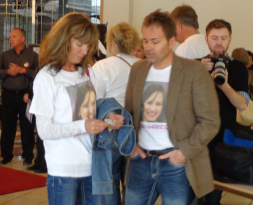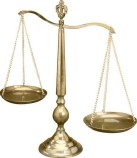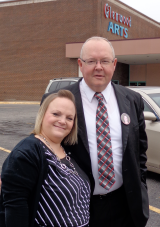
Beth and John Fankhauser in the lobby of the Glenwood Arts Theater, after the premiere showing of The Syndrome.
The premiere earlier this month of The Syndrome, a documentary that questions shaken baby theory, was even more thrilling than I’d expected: The film is riveting, and its first public showing, at the Kansas International Film Festival, drew a crowd so excited to meet each other that the lobby buzzed for an hour afterwards.
Beth Fankhauser was smiling, with tears in her eyes. “We thought we were the only ones,” she marveled. She and her husband John, who are now rearing their grandchildren while their daughter serves her prison time, met half a dozen other accused families that afternoon, reinforcing their decision to start speaking up after six years of waiting quietly and praying for justice.
“We allowed ourselves to be shamed… We thought we had to protect our family from the notoriety,” Beth explained, “But the system has betrayed us, and it’s time for the truth. I feel empowered to know that others are also walking this path.”
A weekend like that was the antidote I needed to get past my disappointment at the 14th International Conference on Shaken Baby Syndrome, in September in Denver, where the emphasis seemed to be on discrediting all critics.
In a breakout session on the first morning, for example, pediatrician Robert Block named me personally as one of the child abuse denialists who have “fooled the media,” and some judges, into thinking there is a controversy in this arena. “I would ask the parents who are here whether they think SBS is a myth,” he admonished, pointing out that writing a blog requires no qualifications and no certification, just like writing a book or making a movie—like Flawed Convictions and The Syndrome. Block objected that all our works disregard the real victims—the injured babies—and focus instead on the perpetrators.
Prosecutor Shelley Akamatsu from Boise, Idaho, reported that prosecutors are pressing abusive head trauma cases harder than ever in the courtroom. She remembered the first shaken baby conference, in Salt Lake City, Utah, in 1996, when “convictions in AHT cases were not common,” she said, because only a few prosecutors, those who had taught themselves, knew how to handle the medical content. Eighteen years later, national training programs have prepared prosecutors “to meet untrue defenses, prove the severity of the forces inflicted, and effectively educate jurors,” she said, so that now “convictions in AHT cases are the norm rather than the exception.”
 Akamatsu called for an organized response now to defending these cases on appeal. “True justice means expertly defending the convictions we’ve worked so hard to get,” she said. “There’s a place for Innocence Projects,” she acknowledged, but “not in this arena, because these cases are so factually driven.”
Akamatsu called for an organized response now to defending these cases on appeal. “True justice means expertly defending the convictions we’ve worked so hard to get,” she said. “There’s a place for Innocence Projects,” she acknowledged, but “not in this arena, because these cases are so factually driven.”
Law professor Joëlle Anne Moreno argued that the courts, the press, and the public are all misinformed about infant head trauma. She dismissed on legal grounds the adequacy of the “new evidence” that was behind the reopening of the Jennifer Del Prete and Quentin Louis cases, the reversal of the Audrey Edmunds conviction, and the minority opinion in the U.S. Supreme Court decision in the Shirley Ree Smith case. “We need to clear up these legal questions,” she said. “Don’t confuse causation with culpability. That’s what Professor Tuerkheimer is doing when she says this is a medical diagnosis of murder.”
Dr. Sandeep Narang, who is both a physician and an attorney, dismissed the idea of any real controversy about abusive head trauma as a fallacy manufactured by the defense and parroted by the media. He devoted the first hour of his talk to the medical literature, concluding that serious brain injury or death from a short fall is “very rare,” bleeding disorders are easy to identify, and both subdural hematoma and retinal hemorrhages are highly correlated with child abuse. The second hour he spent rebutting the “straw man” argument that shaken baby syndrome is “medically diagnosed murder.” He said he was puzzled by the claim that the child abuse literature exhibits circular reasoning:
There’s a lot of accident literature where we just looked at accidents. We didn’t look at abusive cohorts. We just looked at accidents. How is that circular?
Because Dr. Narang had the floor, no one answered his rhetorical question, but this is my blog, so please let me explain: These studies typically start with a series of patients seen at the authors’ hospitals over a period of time. Not infrequently, researchers studying acciden tal injury simply remove from the study any cases of presumed child abuse, with the stated goal of limiting the study to verifiable accidents. The filtering out of abuse cases is typically done by the local child abuse team, or sometimes by the authors. The problematic result is that, if a child comes in with a serious injury and a history of a household fall during the study period, the case is diagnosed as abuse and therefore never appears in the data. This self-fulfilling sorting algorithm also taints the studies that attempt to describe for physicians how to recognize child abuse—for an on-line example, please see http://archpedi.jamanetwork.com/article.aspx?articleid=348423.
tal injury simply remove from the study any cases of presumed child abuse, with the stated goal of limiting the study to verifiable accidents. The filtering out of abuse cases is typically done by the local child abuse team, or sometimes by the authors. The problematic result is that, if a child comes in with a serious injury and a history of a household fall during the study period, the case is diagnosed as abuse and therefore never appears in the data. This self-fulfilling sorting algorithm also taints the studies that attempt to describe for physicians how to recognize child abuse—for an on-line example, please see http://archpedi.jamanetwork.com/article.aspx?articleid=348423.
Which brings me back to something that bothered me when I first read the trial transcripts of the 1996 case that brought this medico-legal tragedy to my attention: As long as the child abuse teams continue to treat every one of these cases as obvious abuse with immediate symptoms, there is almost no way to gather evidence to the contrary. Decades of convictions have been based entirely on sincere but unproven medical opinion, and at this point, the opinion is based on decades of convictions.

Kathy and Kevin Hyatt at the Glenwood Arts Theater, where The Syndrome premiered.
Last weekend I met not only Beth Fankhauser, who says her daughter Megan was watching a 15-month-old who fell off a bed, but also Kathy Hyatt, found innocent at trial in 2009 after a baby she was watching rolled off the couch, and the family of Amanda Brumfield, now in prison, who told emergency responders her goddaughter had fallen trying to climb out of a portable crib. I don’t understand what makes the doctors so sure that all these women, wives and mothers with good reputations in their communities, simply lost it and attacked babies they had been watching for months, babies they knew and loved.
November 2015 Update: You can now host a screening of The Syndrome, http://www.resetfilms.com/hostascreening/
If you are not familiar with the debate surrounding infant head injury, please see the home page of this blog site.
© 2014, Sue Luttner


Pingback: Shaken Baby Conference 2016: Defending a Crumbling Theory | On SBS
Pingback: Innocent Family Petition Hits a Nerve | On SBS
You state that you spoke to parents whose daughter was babysitting a child who fell off a bed and died. How do you know that is what happened? You state it as if it is a fact. It is simply your belief, which knowing the horrific injuries that child sustained, I believe is incorrect. Do you investigate these cases or just take the word of convicted? There was a trial with an abundance of evidence of guilt.
Good eye, Susan. My writing was imprecise. I do not know; I was not there. I’ve added the words “who says” to the sentence.
try being the parent of a child who has an abuser that actually confessed to the crime and went to prison for confessing… And 15 years later my child has been in the Children’s Hospital for six months because of the effects of shaken baby syndrome that happened to her 15 years ago…let’s try to say this actually doesn’t exist
I am so sorry for your suffering, and your daughter’s.
I agree that violent shaking of an infant can cause permanent damage, even death. My point is that the bleeding and swelling commonly diagnosed as shaken baby syndrome can have other causes.
Pingback: “The Syndrome” Trailer Makes Waves | On SBS
Hi Sue,
What is the news from International Conference on Shaken Baby Syndrome/Abusive Head Trauma 2014 in Europe? Anything promising?
I did not attend the NCSBS Paris conference in the spring, http://dontshake.org/conferences.php?conID=19&topNavID=5&&subNavID=39, and I don’t know of any others.
Sue, what an honor it was to finally get to meet u in KC!!!! I loved all of us being together. It was a breath of fresh air for sure!!! I do hope our paths cross again sometime!!!
Thank you, Kathy, and I feel the same way. When I made my plans, it seemed like an outrageous indulgence to travel to Kansas City for a film, but being there and meeting you was beyond fabulous. This project has been a challenge from the beginning, and extremely isolating. It was immensely valuable for me to connect in person with other people who understand what’s going on.
Think about the parents who live this on a daily basis…you can all sit here and believe that shaken baby syndrome doesn’t happen but it does and I have a confession I know it exists and I know what it’s done to my child
Sue, great job in highlighting what is a clear and underlying problem with these cases-they are tried in the ER. And it’s really no wonder why the debate continues in the medico-legal community. The studies on which these hold-outs rely are bias from the get-go as the child abuse team or authors screen the cases to be studied. A child with a serious injury and a history of a household fall during the study period is diagnosed as abuse and therefore never appears in the data. This is exactly what happened in our case. The ER doctor reports abuse. This goes to the police and the ME and now the entire investigation and trial are prosecutorial-driven.
Thank you for your kind words, and thank you for all the work your team has done in the arena. (The web site in support of Brian Peixoto, http://brianpeixoto.com/ is as thorough as it is articulate.) Best wishes to Brian and to the many others in his position.
You have been excellent support to the people and families who have suffered the abuse of these doctors and a legal system that won’t take a look at past mistakes. I pray you will keep up the good work you do and that these individuals who can’t look past their egos finally see the truth. Nancy O’Geary-Smith
Thank you, Nancy. It has been my honor to watch the strength, honesty, and dignity you have brought to this arena through the years. And patience, may that pay off. Best wishes to you and your family.